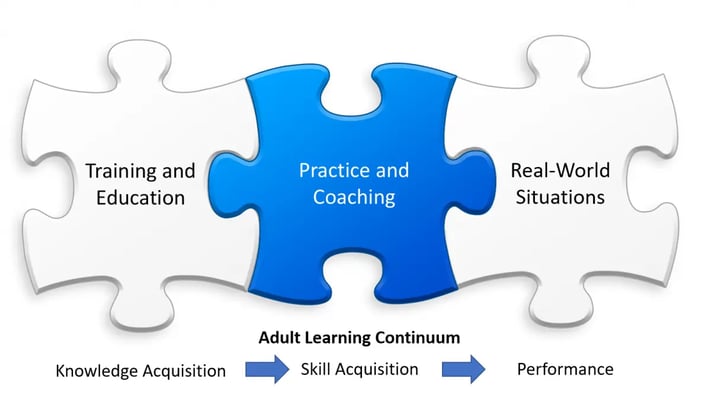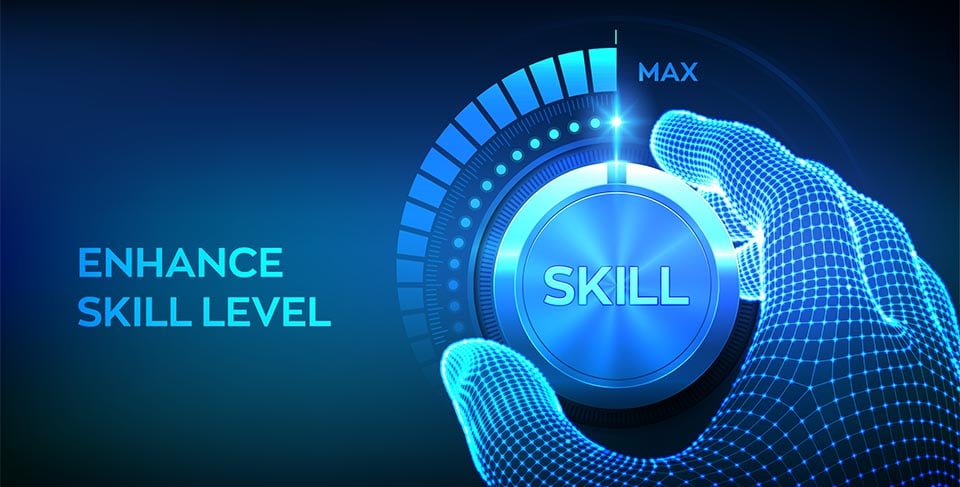
(Originally published in Training Journal)
Training provides knowledge, but without practice, it quickly recedes and becomes a wasted investment. What can we do?
Call of Duty immerses gamers in a realistic virtual experience. Virtual game technologies can be adapted to do the same thing for business people – immerse them in realistic situations where they can safely practice making decisions, and then receive expert feedback and coaching. It’s a perfect fit for many training applications, such as leadership development, or adopting new processes in sales and coaching.
5 Reasons Why Practice Works
Intuitively, we know that practice with coaching improves performance. However, there’s an unspoken rationalization that says knowledge workers are somehow different. You just give them the knowledge and a process to follow, and then magic happens; their performance improves. The host of reasons why this is not true, are the same reasons that make the case for investing in practice - to invest in Call of Duty for business. Let’s consider just five reasons why practice works.

- Lowers barriers for adopting new behavior. There are many reasons why employees do not adopt new behaviors from training. Safe practice develops both competency and confidence.
- More engaging. When learners are challenged to apply what they learned in realistic situations, it gives them a first-hand look at the meaning and purpose for the training – “the why.”
- Higher retention. Gamification, microlearning, and spaced learning make training more memorable. However, the best way to improve retention is through personalized experience, using the training content in a realistic, controlled environment.
- Grounded in cognitive science. Effective skill acquisition – the doing – utilizes different cognitive science principles than knowledge acquisition – the knowing. For example, cognitive apprenticeship provides a structure for practice and coaching. It’s an apprenticeship for thinking skills.
- Pattern Recognition. Because situations are often nuanced, practice enables learners to recognize patterns so they can optimally respond. Over time, their mental models used to make decisions become more robust, resulting in better performance.
So Why Virtual Practice?
Wouldn’t we all like to learn by practicing one-on-one, with a mentoring coach? Of course! That’s how athletes and musicians reach exceptional levels of performance. But for corporate organizations, mentors (coaches) with subject matter expertise are often in short supply, and expensive to scale. Even “virtual” one-on-one coaching has this scale problem.
So, if human mentors are not scalable, what are the options?
It’s the choice between:
- Doing nothing after training
- Filling in the gap with passive approaches like video or webinars
- Creating virtual practice and coaching using technology as a surrogate for a human mentor.
Given these options, virtual technology is attractive. Let’s explore how to put it into action.
3 Steps to Get Started with Virtual Practice
Before diving into the 3 steps, let’s set some expectations. Someday we may be able to interact with a “virtual mentor” powered by artificial intelligence to help us learn quickly. However, a brief conversation with Apple’s Siri or Amazon’s Alexa demonstrates that we are years away from this. Even so, very compelling realism can be achieved through algorithm-based AI that video games have used for years.
Let’s get started!
Step 1. Identify Performance Gaps. You may be thinking, “What? We’re talking virtual technology, so why is this first?” Well, it’s because performance gaps should drive decisions on which technologies make sense. There is so much hype out there about virtual technologies, that often the technology decision clouds the real purpose – not “awesomeness,” but improved performance.
Performance gaps are the behaviors that separate your best performers from your average ones. Many organizations may not explicitly measure this. Even if you don’t, you can quickly find these gaps. To start, look at your processes. Processes are broken down into steps, that when followed, create scalable, consistent performance. Look at each step and consider what should be happening, versus what’s really happening – that’s your performance gaps.
Step 2. Choose the Appropriate Virtual Technology for the Learning Goals.
Let’s explore two options.
 Virtual reality (VR) is top-of-mind for many training organizations. It’s awesome technology where a headset immerses learners in 3D physical environments that they can look around in. Ask yourself, is ‘looking around’ critical to your learning goals? For leadership development, sales processes, or challenging business situations, it’s the conversation – right in front of the learner, not the physical environment, that’s important. In these cases, VR adds cost and limits accessibility, with little gain on learning efficacy.
Virtual reality (VR) is top-of-mind for many training organizations. It’s awesome technology where a headset immerses learners in 3D physical environments that they can look around in. Ask yourself, is ‘looking around’ critical to your learning goals? For leadership development, sales processes, or challenging business situations, it’s the conversation – right in front of the learner, not the physical environment, that’s important. In these cases, VR adds cost and limits accessibility, with little gain on learning efficacy.
 Game Technology can immerse learners in all sorts of virtual 3D environments. For decision-making in business, conversational virtual humans are the ideal focal point. In the best of these, learners are immersed in a situation where they make decisions, experience the results, and receive mentoring dialog from virtual humans. Therefore, it’s not a game, but a 3D learning environment that creates a safe haven to practice new behaviors.
Game Technology can immerse learners in all sorts of virtual 3D environments. For decision-making in business, conversational virtual humans are the ideal focal point. In the best of these, learners are immersed in a situation where they make decisions, experience the results, and receive mentoring dialog from virtual humans. Therefore, it’s not a game, but a 3D learning environment that creates a safe haven to practice new behaviors.
Step 3. Implementation. There are essentially three ways to go here. First, an off-the-shelf solution, that is not built around your performance gaps, may be adequate for certain types of training. Second, a custom solution can be specific to your needs, but will take time, effort, and expense to bring into the organization. Third, a platform approach can allow customization to your needs (with some constraints), and provide economical scale, maintainability, and expandability.
In choosing a solution, there are several considerations. Ask where it’s hosted. Is it an installed app in the Apple or Android store (not available on PCs)? Or is it accessible from any web browser on PCs and mobile? Also ask if the solution has robust analytics. After all, your learners are making decisions, so knowing where they’re struggling and succeeding would be invaluable. Finally, if you’re going the customized route, ask if the content can be modified in the future. Often custom projects are difficult or impossible to modify.
Final Word
If you’re struggling with knowledge transfer after training, enlisting the help of virtual humans may be the solution! They’ll allow your learners to practice safely, in realistic situations. Think of it as Call of Duty for Business, where improved performance makes everyone a winner.
About Syandus: Virtual immersive learning technology that transforms knowledge into real-world performance. We immerse participants in realistic virtual situations with one-on-one expert coaching that gives them experience making optimal decisions. Syandus Learning Modules combine cognitive science principles, the realism of game technology, and our customer’s proprietary content, to deliver rapid skill acquisition. Modules are cloud-based for easy deployment, fully trackable with embedded analytics, and can be used on any web-enabled device.




